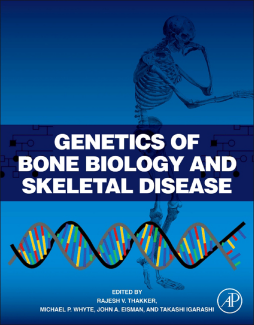
BOOK
Genetics of Bone Biology and Skeletal Disease
Rajesh V. Thakker | Michael P. Whyte | John Eisman | Takashi Igarashi
(2012)
Additional Information
Book Details
Abstract
This book identifies and analyzes the genetic basis of bone disorders in humans and demonstrates the utility of mouse models in furthering the knowledge of mechanisms and evaluations of treatments. The book is aimed at all students of bone biology and genetics, and with this in mind, it includes general introductory chapters on genetics and bone biology and more specific disease-orientated chapters, which comprehensively summarize the clinical, genetic, molecular genetic, animal model, functional and molecular pathology, diagnostic, counselling and treatment aspects of each disorder.
- Saves academic, medical, and pharma researchers time in quickly accessing the very latest details on a broad range of genetic bone issues, as opposed to searching through thousands of journal articles.
-
Provides a common language for bone biologists and geneticists to discuss the development of bone cells and genetics and their interactions in the development of disease
- Researchers in all areas bone biology and genetics will gain insight into how clinical observations and practices can feed back into the research cycle and will, therefore, be able to develop more targeted genomic and proteomic assays
-
For those clinical researchers who are also MDs, correct diagnosis (and therefore correct treatment) of bone diseases depends on a strong understanding of the molecular basis for the disease.
"With the aims of identifying and analyzing the genetic basis of bone disorders in humans and of demonstrating the utility of mouse models, this volume presents 36 chapters that are inter-related, yet self-contained, with some overlap. Coverage is comprehensive."--Reference and Research BookNews.com, April 2013 "The last ten years have witnessed an explosion in genomics and through its application to bone biology, the identification of novel potential targets for therapeutic interventions in bone diseases, such as osteoporosis. This textbook is therefore very timely and integrates a review of bone biology with the genetics of bone and joint disorders, parathyroid and related disorders, and vitamin D and renal diseases. The section on osteoporosis genes identified by genome-wide association studies is particularly useful and effectively summarises a subset of the at least 56 loci that have shown a robust association with BMD at genome-wide significant level and have been replicated. Although these genes explain only about 4% of the variation in BMD and cannot be used to improve fracture risk prediction, they have pinpointed many factors in critical molecular pathways in bone that provide promising candidates for novel therapeutic interventions. The section on genetic disorders of vitamin D synthesis and action elegantly shows how the study of affected children with 1a-hydroxylase deficiency and hereditary vitamin D resistant rickets continues to provide a more complete understanding of the biological role of 1,25(OH)2D in vivo. In conclusion, if you want to find one place to "bone up" on the genetics of skeletal disease, this is the book for you!"--Professor Peter R. Ebeling MD FRACP, The University of Melbourne, Melbourne, Australia "This book brings together the world’s most expert bone biologists, clinicians and geneticists to provide a cutting-edge review of bone from a genetic perspective. It provides a well-written account of bone biology, genetic techniques in general, and their application to bone biology and therapeutics, both of common and esoteric conditions. It provides an accessible and comprehensive treatment of one of the most rapidly advancing areas of bone research today."--Prof Ian Reid, BSc, MBChB, MD, FRACP, FRSNZ, FRCP, Faculty of Medical and Health Sciences, University of Auckland, Auckland, New Zealand
